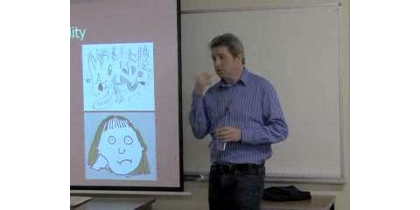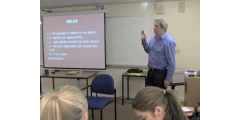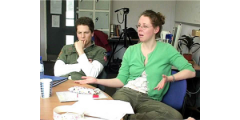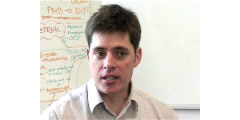Storytelling and role play in developing communication skills
April 14, 2008
Video >> Interviewer: “I know it’s something that you’ve been interested in for a number of years is the role of storytelling in teaching. Could I ask you to say a few words about that?” Paul: “Yeah, a few years ago now I wrote a book, with my wife Rhiannon, Storytelling in Therapy, which was …
Engaging students in learning communication skills
Video >> Paul Crawford: “The key for me is engagement, some students, for one reason or another, might be tiredness, maybe family problems or maybe just they’ve not, sort of, keyed in. I don’t think they’re to be ignored, so I’m working at engagement even with people that might be difficult to engage with for …
Using problem-based learning in your teaching – advice for colleagues
March 15, 2008
Video >> Maggi Savin-Baden: “Start by saying it isn’t particularly new, lots of people assume immediately that it is something new and it’s, you know, all symbols and bright lights, but it isn’t really. “I mean it starts with the premise that people start learning through a problem situation of some description that is related to …
Using problem-based learning to develop critical thinking skills
Video >> Paul Garrrud: “Another benefit of the structure we have of working through a case in three group meetings, and obviously they do quite a lot of thinking and research out with those group meetings, is that it gives them an appreciation and some experience of clinical reasoning. “From the patient who walks in …
What do you need in a problem-based learning room
Video >> Kate: “We’re sitting in one of the Derby PBL rooms now – what are the special features about this kind of workspace?” Jonathan Ball: “I think the key elements are the fact that it’s very Arthurian, so there’s a round table and as a facilitator you’re certainly one of the group, rather than kind …
The problem-based learning cycle
Video >> Session 1 Pete Jennings: “PBL starts with session 1 – here at GEM it’s divided into 3 sessions. So session 1, the students come together, they’re presented with a trigger text which gives them enough clues to hopefully identify questions that they might have around certain topics.” Student group working Students: “Low energy …
Preparing for using a student response system in your lecture
February 23, 2008
Video >> Interviewer: “So how do you actually do it?” Andrew: “OK, there’s some software you can download and basically it runs in conjunction with Powerpoint. So you run your Powerpoint presentation and then it’ll just give you an option of “Insert chart”, and then you can insert the type of chart you want and …
Using student response systems to improve interaction in lectures
Video >> Andrew Fisher, Philosophy: “Before, I was doing showing of hands in my modules, which is OK, but people are reticent sometimes to be seen, especially if the subject is quite controversial. So if I asked about fox hunting and there’s one person who thinks its OK they’re less likely to put their hands …
Altering lectures in response to student input
Video >> Interviewer: “Does the student voting actually affect what you deliver in the lecture?” Andrew: “Yes, yep, it does. I know where I want to go, and how to get there is pretty much mapped out, but I’ll put a different emphasis on things. So if typically I’ll have a thought experiment sort of …
Purposes of student-led seminars: development of transferable skills
June 26, 2007
Video >> Kate: “Hi Nick, thanks very much for coming over from the School of History.” Nick Thomas, History: “That’s OK.” Kate: “I wanted to ask you about seminars and seminar teaching. What is it you actually want your students to gain from participating in seminars?” Nick: “A number of different skills. We look to …










